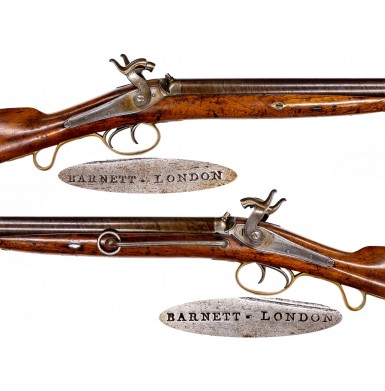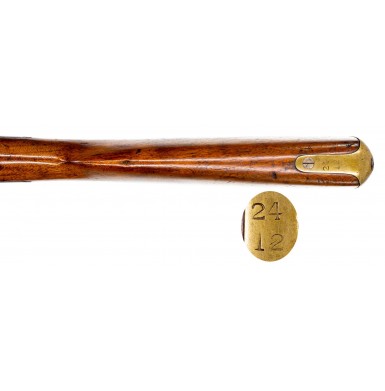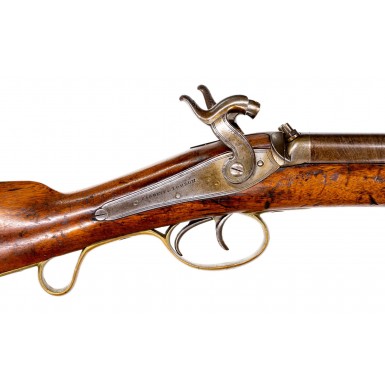Extremely Rare Barnett Cape Cavalry Double Barrel Carbine in Fine Condition
- Product Code: FLA-3780-SOLD
- Availability: Out Of Stock
-
$1.00
During the first half of the 19th century the British Board of Ordnance showed a fascination with the concept of the double barrel carbine, both in flint and percussion ignition systems and with both smooth and rifled bores. While technically these shorter than infantry length arms could be considered “shotguns” in smoothbore or “double rifles” when rifled, the guns were all classified as “carbines”. The deigns never saw significant issue with front line troops and in most cases were used in colonial settings, often by local authorities and militia groups. The double barrel carbine concept seems to have seen the most use in Ireland, South Africa and India. In fact, British arms researcher and author DeWitt Bailey note that: “The most confusing group of carbines made during this period (1815-1865) was the series of double-barreled weapons made variously for use by mounted troops in Ireland, South Africa and India. The very small numbers of these arms made, coupled with officers’ own ideas being wedded to basic service patterns to produce their own personal arms for colonial service, presented a selection of carbines with is very difficult to define with any degree of certainty.” The majority of the double barreled carbines to be produced during the mid-19th century would be designated as “Constabulary Carbines” and see use primarily in Ireland with the local government police forces. One of the primary differences that would differentiate the “constabulary” carbines from the guns carried by the more military organizations would the fact that the constabulary guns typically accepted a bayonet, while the militia guns usually did not. The other primary difference was that the constabulary guns typically used sling swivels as they were often issued to men on foot, while the militia carbines were usually equipped with a sling bar and ring for mostly mounted use.
The first major entry into this category of double-barreled carbines was the Cape Cavalry Carbine of 1822. This was the only double barrel carbine in British service to utilize flint ignition and was a somewhat heavy and awkward musket bore long arm that was nominally .73 caliber. The gun was a smoothbore and was intended for use by the Cape Cavalry, a South African militia force that operated variously as the Cape Regiment (1795-1827) which included both infantry and cavalry units and later the Cape Mounted Riflemen (1827-1870), after the disbanding of the infantry contingent. The origins of the Cape Regiment had been with the earlier Dutch rulers of South Africa, who had established the Corps van Pandoeren (Corps of Pandours) for local defense, in 1793. Interestingly the corps was established not so much for local defense against hostile African natives, but rather as a reaction to the unrest in Europe during the period and the fear that other colonial powers might seek to capture the Dutch colony of South Africa. In an amazingly progressive decision for the time, the original Dutch regiment was comprised primarily of local African (black) soldiers operating under the command of European (white) officers. When the British took control of the Dutch colony in 1795, the regiment was retained and renamed it the “Cape Regiment”. In another change of control, the Dutch retook the colony in 1803. Again, the regiment remained in existence, although the name was changed to the Corps van Vrye Hottentotten (Corps of Free Hottentots), referencing the local tribe to which the free Africans belonged. In 1806 the British regained control of the colony again and would maintain that control until South Africa was made a fully sovereign nation state member of the British Empire in 1934.
When the British retook the South African colony, the regiment was again renamed the Cape Regiment and was also briefly referred to as the Cape Corps. At this time the British turned their attention to expanding the South African colony and moved the Cape Regiment to frontier duty, protecting the settlers from incursions from the indigenous people. The Corps was officially renamed the Cape Mounted Rifles in 1827 and would operate under that designation through 1870. During that period the Corps was exclusively mounted with no infantry components and despite its name, most of the soldiers were not armed with rifled arms. During this period the Cape Mounted Rifles were engaged the second half of the Xhosa Wars, which were also known as the Cape Frontier Wars or the Kaffir Wars. This series of nine major conflicts ran for a century, from 1779 to 1879. The Cape Mounted Rifles were active during the 6th Frontier War (1834-1835), the Siege of Durban (1842) the 7th Frontier War (1846-1847), the 8th Frontier War (1850-1853) and the Basuto War (1850-1852). During the early part of this period the original Cape Double Barreled Carbine of 1822 was one of the primary long arms for the corps, with a percussion version of the gun coming into use around 1840 and remaining standard until finally being superseded by a rifled double-barreled Cape Carbine in 1853.
The Cape Double-Barreled Cavalry Carbine of 1840 was little different from its predecessor in the 1820s. It was a heavy, double barreled gun that was “musket bore”, nominally .74 caliber. Like the earlier flintlock version of the gun was smoothbore with a pair of backaction locks, however these were percussion locks. The gun was nominally 43” in overall length with a pair of heavy, ribbed 26” twist-steel barrels that terminated in a break off breach. The barrels were retained by the lugs on their rears that engaged the breech block and a single wedge through the stock. A sling bar was attached to the reverse of the stock with a sliding ring. One of the more unique features of the design was a captive swivel ramrod with a wide oval mount at the muzzle that allowed the rod to be slid left or right for easy use in either barrel. Furniture was of brass and included a large, scroll-shaped triggerguard, the buttplate the forward sling bar mounting screw escutcheon and the reinforcement to the entry hole in the forend for the ramrod. DeWitt Bailey notes that very few of these guns were officially delivered through the British Board of Ordnance, and the presence of Ordnance proof marks or Government ownership marks like a crowned Broad Arrow would be necessary to officially designate the gun as being true Ordnance supplied carbine. He notes that the majority of the Cape Carbines that were produced and delivered were acquired through “private channels”. The example that Bailey illustrates is actually a commercially produced example manufactured by Barnett that bears British government proof and ownership marks. As the guns were produced in relatively small quantities it is unlikely that the Cape Carbines were ever produced by anyone but private contractors, and I have never seen or heard of one by anyone other than Barnett. Interestingly, a nearly identical gun was adopted for use by the Irish Constabulary in 1839, with the primary differences being the lack of a cavalry sling bar, the inclusion of sling swivels and the inclusion of a bayonet mounting bar that accepted a heavy brass handled saber bayonet based upon the Brunswick Rifle bayonet.
The Cape Double Barreled Cavalry Carbine offered here is in about VERY FINE condition and retains most of its original browned twist pattern finish on the barrels. The gun is clearly engraved in script on the barrel rib:
Cape Cavalry
The back action percussion locks are clearly stamped in a single line:
BARNETT • LONDON
The Barnett family was one of the most storied and longtime gunmaking dynasties in London. The family traced their gunmaking heritage to Thomas Barnett who operated in London as early as 1796. In 1811, the firm became Thomas Barnett & Sons, with John Edward Barnett subsequently succeeding to the business in 1833. In 1842, the firm was renamed JE Barnett & Sons and operated under that name until 1901 when they became JE Barnett & Sons LTD, finally going out of business in 1908 after more than a century in the gun making trade.
The butt of the carbine is stamped with an issue number of 24 over 12, possibly indicating “24th Troop”, “12th Gun” or something similar. The gun is a commercial gun delivered to the Cape and does not have British government proofs or ownership marks. In fact, the proof marks under the barrels are non-standard and appear to be nd/2/F, the meaning of which I do not fully understand. The gun has the file slash assembly mark / / on all major components, including under the barrels and on the upper edges of the locks. The ramrod is maker marked T&CG, indicating manufacture by the long time Birmingham “small work” makers Thomas & Charles Gilbert. The Gilbert’s specialized in the making of small gun parts like screws, bands, ramrods and gun tools and worked from 1842-1862 at 56 Staniforth Street. The 5.5” long sling bar is marked on its bottom with the initials of its maker, which are JA and a partial inspection mark is present on the bottom the bar, but as it is stamped on a rounded surface and only part of the mark is visible. Bailey mentions that Barnett apparently used left over parts and even used barrels in the production of some of these carbines, which would make sense as they were small orders for what were not a standard production item. During the Civil War Barnett would similarly refurbish older British military guns and sometimes use old or used parts to make up guns for sale to the Confederacy.
As noted, the gun remains in VERY FINE condition. The 26” barrels retain about 85%+ of its period browned twist finish, with some thinning, wear and loss. The gun was coated with a thick layer of oil or grease long ago to preserve it, and some areas of hardened old oil are present on the metal. This gives the metal a somewhat textured feeling in some areas but is not pitting. Rather it is just old, hard grease residue and some scattered light surface oxidation. A good cleaning with denatured alcohol should remove most of this. The barrels do show some scattered light pinpricking and some scattered surface oxidation here and there, with the breeches showing the most evident areas of light erosion and wear. There is some light surface corrosion around the muzzles as well. The color casehardened locks retains some traces of finish on their interiors but have a mostly silvery gray appearance on their exteriors. Both locks function crisply and correctly on all positions and the locks and barrel rib both retain strong, clear markings. The bores of the gun are nominally .75 caliber and both remain in FINE condition and are mostly bright with some scattered light oxidation and discoloration along the bores and some small areas of minor surface roughness. There is a small ding on the right side of the right barrel, about 2” from the muzzle and a minor ding on the face of the right barrel’s muzzle, near the ramrod disc. The left barrel is very slightly out of round at the muzzle, again almost certainly the result of ding; not uncommon for a gun carried muzzle down on a sling from a sling bar. The original swivel ramrod is present, complete and fully functional, operating exactly as it should. The brass furniture has a rich ocher patina and is untouched and very attractive. The stock is in about NEAR FINE condition and remains solid, full-length and free of any breaks, cracks or repairs. The stock shows numerous bumps, dings and mars from handling and use and but shows no abuse, damage or excessive wear.
Overall, this is a very attractive and scarce example of a Barnett Cape Cavalry Carbine in a wonderful state of preservation. The gun is 100% complete and correct and remains quite crisp with lots of finish and clear markings. These guns rarely appear on the market and are an interesting piece of British colonial firearms history. In fact, rarely are firearms related to the colonial history of South America appear on the market, with the exception of the occasional Boer War era Mauser rifle. No collection of mid-19th century British firearms is complete without at least couple of their unusual double-barreled carbines. This would be a fine addition to any such collection and is a high quality gun that you will certainly be glad to add to your collection and display.
SOLD
Tags: Extremely, Rare, Barnett, Cape, Cavalry, Double, Barrel, Carbine, in, Fine, Condition










